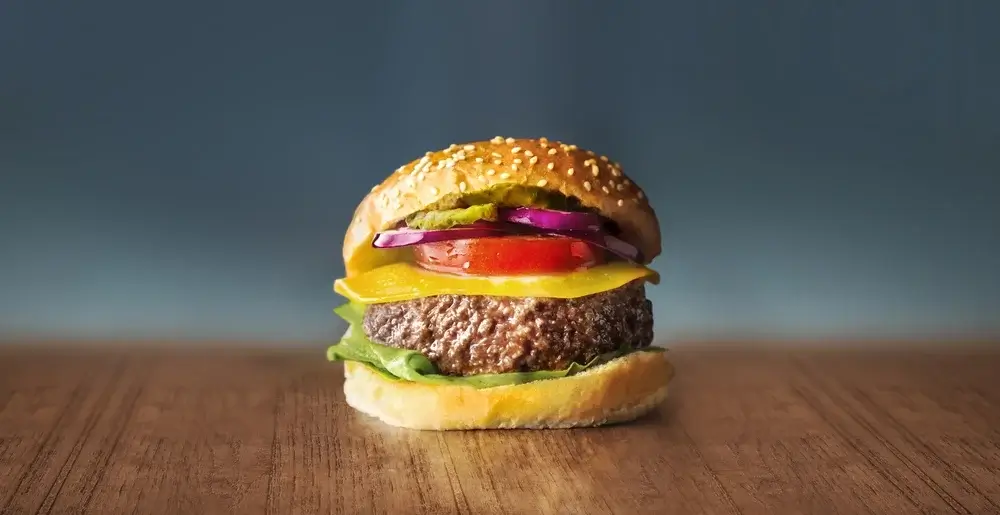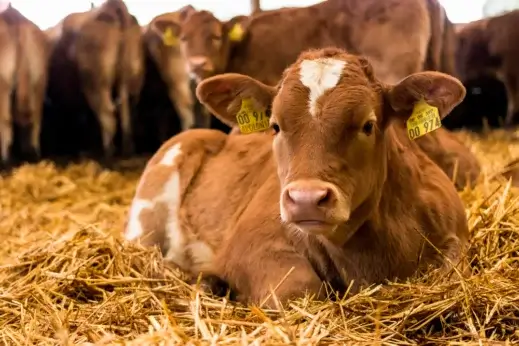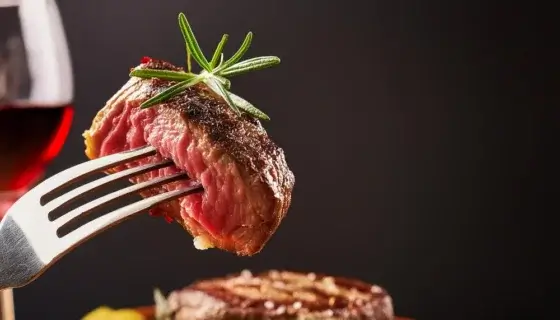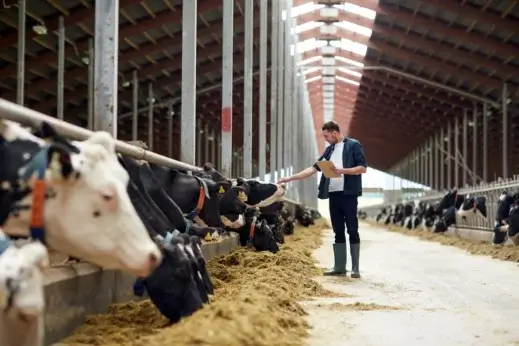Inside Florida’s Ban on Lab-Grown Meat
The recent move to criminalize cultivated protein has more to do with politics than science.
Inside Florida’s Ban on Lab-Grown Meat
The recent move to criminalize cultivated protein has more to do with politics than science.

by Shutterstock/Mosa Meat
Florida Governor Ron DeSantis walked up to the podium displaying a “Save Our Beef” poster — the logo designed as a parody of the World Economic Forum’s brand. Before him sat a small crowd dotted with cowboy hats. Here in Wauchula, a small farming town in Central Florida, cattle ranching is king. “We’re here today to sign the bill that continues our commitment to having a vibrant agriculture industry,” DeSantis announced. “Take your fake meat elsewhere — we’re not doing that in the state of Florida!” May 1st marked the official signing of SB 1084, a bill that makes it illegal to sell, distribute, create or otherwise possess lab-grown meat. Florida became the first state in the U.S. to ban the emerging protein alternative, but it’s not the last. The narratives pushing these bans forward are familiar even if not founded: climate denial, baseless fears about “long-term health problems” and conspiracy theories featuring Bill Gates.
One week later, Alabama passed a similar ban, and Arizona and Tennessee are also poised to follow suit. A long list of other states, meanwhile, have banned the word “meat” from cultivated meat packaging.
Yet the movement to ban lab-grown meat isn’t confined to the U.S. Italy became the first country to criminalize cultivated meat in 2023, as well as banning the use of words like burger and sausage on packaging for alternative proteins. Meanwhile, in the Netherlands, the same farmers struggling with the effects of climate change, like drought, are revolting against stricter regulations on pollution from livestock manure.
Conspiracy Theories and an Ongoing Culture War
Dozens of peer-reviewed studies have shown that livestock accounts for anywhere between 11 and 20 percent of global greenhouse gas emissions, much of which comes from land use and cow burps. As part of the solution, groups like the World Resources Institute have suggested that consumers in countries with higher per capita meat consumption — like the U.S. — could reduce their food-related emissions by shifting 40 percent of their meat-based diet (cows, sheep, goats) by 2050 to meat alternatives, whether plant-based or lab-grown, or a mix.

Unsurprisingly, DeSantis is not on board, and his speech that day was littered with misinformation. He denied that meat is making climate change worse, and presented the alternatives to be banned as a plot against the meat industry. “One of the things that these folks want to do, is they want to eliminate meat production in the United States,” DeSantis said at his press briefing. “The goal is to get to a point where you will not be raising cattle.” While that may be the goal of cultivated meat backers, the reality is the industry is a fraction of the size of Big Meat. A more realistic hope might be that one day cultivated meat could be one way out of many to reduce how much meat we consume.
And of course, the public still has a choice in the matter. “This is not about forcing people to eat cultivated meat,” Nico Muzi, co-founder and managing director of Madre Brava, a food and environment advocacy organization, tells Sentient. “This is about allowing a technology to be developed and potentially marketed.”
DeSantis did not shy away from the most common misinformation, including jabs at Bill Gates, the “global elite” and the campaign to make the world eat insects. Many of these points echo the “Great Reset” conspiracy theories promoted by far-right political and media figures dating back to the pandemic, Nusa Urbancic, CEO of the Changing Markets Foundation, an advocacy group favoring sustainable markets, tells Sentient. (Perhaps not coincidentally, Jeff Bezos invested a reported $60 million into lab-grown meat in Florida just before DeSantis signed the ban into law.)
These conspiracy theories are baseless, but they are also practically endemic in some online spaces. In a Changing Markets report analyzing anti-alternative protein messages on social media over a 14-month period, the majority of posts were linked to various aspects of the Great Reset conspiracy theory. For example, when a 2022 heatwave killed thousands of cattle in Kansas, some people falsely suggested they were purposely killed to boost Bill Gates’ lab-grown meat business — steamrolling over the scientific evidence for extreme heat spurred by climate change. Indeed, the mocking “Save Our Beef” sign at the DeSantis press briefing echoed the idea that the World Economic Forum, Bill Gates and other forces have an agenda to take over.
“Florida’s ban and soon Pennsylvania’s ban of cultured meat clearly demonstrates the prevailing ignorance of science among consumers at large and policy makers (often backed by deep-pocket science doubters),” wrote Kantha Shelke, founder of a food science firm called Corvus Blue, LLC and lecturer at Johns Hopkins University, in an email. These bans hinder innovation rather than seek protocols for vetting new technologies in food science, she added.
Proponents of this narrative also point to a non-peer reviewed 2023 University of California, Davis, study that claimed lab-grown meat was 25 times worse for the climate than traditional beef. Though the study was a preprint and vigorously contested by scientists who work in the cultivated meat field, many media outlets printed the headline of the study, and the damage was done.
That might be part of the reason why misinformation about meat and climate change isn’t limited to people who believe conspiracy theories. A shocking 74 percent of respondents to a Washington Post poll said cutting out meat would have little or no impact on climate change, despite the bulk of evidence showing the climate impacts of livestock farming, especially beef.

The Chewy Science of Cultivated Meat
Even as the 18th-largest cattle ranching state, Florida’s cattle history has deep roots dating back to Spanish colonization in the 16th century. Among the long legacy of cattle ranchers is Dusty Holley, director of field services for the Florida Cattleman’s Association and a seventh-generation Floridian whose family has been cattle ranching since the early 1800s. “We know that meat is something that people eat that’s from a muscle of an animal,” he said. “We’re not really sure what this lab-grown protein is.”
In actuality, cultivated meat is not that mysterious. Lab-grown meat made its public debut in 2013, when researchers at Maastricht University served the first lab-grown beef patty on live television. It became known as the $325,000 burger, one that needed salt and pepper, according to one taster. Since then, technological advancements have skyrocketed, bringing the average cost estimate — as of today — down to about $10, which is still more expensive than standard beef.
Although opponents like to say it’s not real meat — and shouldn’t be labeled as such — it’s near-identical to the beef and chicken coming out of slaughterhouses. “There’s no ingredients we’re bringing to the process that’s any different than what an animal uses to grow,” says David Kaplan, a biomedical engineer who leads a cellular agriculture lab at Tufts University. He argues that it’s as safe as traditional meat. Indeed, the FDA and USDA have protocols in place to regulate cultivated meat approved for sale in the U.S.

The reason cultivated meat is virtually identical is that it’s made from meat cells. First, scientists take a small biopsy of muscle, which causes little to no harm to the live animal. To get those initial cells to grow, scientists “feed” them a growth serum. Initially, companies used what’s called fetal bovine serum — the blood of cow fetuses after the mother is slaughtered — to keep these cells alive. The cells need some sort of scaffold to latch onto, like stripped-down broccoli or spinach, and then will grow in large tanks called bioreactors to become burger, pork shoulder or chicken thigh. The process itself isn’t entirely new; it’s similar to how scientists grow human organ cells for medical purposes, Glenn Gaudette tells Sentient. Gaudette is a biomedical engineer at Boston College who has grown human heart cells for cardiovascular diseases, and is now applying his research to cultivated meat.
The potential to make meat, only without the ranch, has felt like a blow to generational farmers like Holley. “You build this, one, great track record of consumer safety, and two, strong consumer confidence,” he says. Seeing the USDA stamp on meat packaging in the grocery reassures people it’s safe for them and their families, he added. “It’s been that way my whole life,” Holley tells Sentient. “A product that we’re not really sure what it is — it should not step right in and be labeled as meat.”
In reality, there is a very long way to go before cultivated meat could really cut into the meat industry. There are a slew of challenges to scaling production in a way that makes it economically viable. For one, the process is water- and energy-intensive, so researchers are looking into ways of using renewable energy to fuel the process. It also requires completely sterile and temperature-controlled environments, which are expensive. Compared with the global meat production, cultivated meat is still in its infancy. The budding industry has raised $3.1 billion in investments compared with the meat industry’s revenue of $1.3 trillion.
Stoking Fear Among Farmers
Although the science is relatively straightforward, narratives about the safety of lab-grown meat persist, especially among farmers and their powerful lobbies. Beyond states like Florida and Texas, where cattle ranching groups have an influential voice in state politics, farm lobbies in Italy and the Netherlands have stalled critical climate and environmental policies.
In reaction to the European Union’s Green New Deal, which proposed reducing pesticides, restoring nature and planting more climate-resilient crops, Dutch farm groups have pushed back. “Politicians in Europe are really concerned that these farmers will move too far right if they don’t give them whatever they want,” says Urbancic, the Changing Markets CEO.

In Florida, appealing to farmers is a well-worn political tradition. “I’ll bet many of you didn’t know that I’m a farmer’s kid,” Senator Jay Collins, who introduced the bill banning lab-grown meat, said at the May 1 press briefing. “Our family struggled coming out of the ’80s. It turns out that Democratic policies weren’t good then either, and our family ended up losing our farm.”
No matter the perception of reality, animal agriculture is still the second-largest contributor to greenhouse gas emissions behind fossil fuels and is the number one cause of deforestation and biodiversity loss. It also uses about a third of global grain production at a lower output; 25 calories of cattle feed, for example, produces just one calorie of beef, according to Yale’s Center for Business and the Environment. Beef is considered the least efficient type of meat.
Maybe it doesn’t have to be one or the other. Integrating cultivated meat technology with more traditional forms of agriculture could also help reduce the impacts of meat production and its drain on natural resources, Gaudette suggests. “What if we were to grow more meat from the same number of cattle, or grow more meat from fewer cattle, so that now we can have more water?” he said, adding that the approach should be collaborative. “There are farmers that are hard workers that are concerned about losing their livelihood,” he said. “So can we involve them in this process?”
A cultivated meat collaborative just like this is underway in the Netherlands, in fact. The argument that cultivated meat threatens agriculture is paradoxical, says Madre Brava’s Muzi, whose parents are Argentinian ranchers. “This push against cultivated meat is the work of a very specific way of producing meat,” he said, adding that it favors industrialized agriculture that keeps big farmers in power while pushing out small and medium-sized ones. It perpetuates a global, resource-intensive system where animal feed like soy is causing deforestation in parts of South America. “In a world where we need to feed a lot more people, meat…will still be demanded and exacerbating climate change and deforestation,” Muzi said.
He adds that alternative proteins would help farmers. “An important shift to this type of alternative proteins could free up a lot of farmland to allow for more agroecological farming,” he says, such as incorporating rewilding projects to mitigate emissions.
Kaplan says he sees the knowledge gap about the science of cultivated meat — and it’s a responsibility he places on himself. “We don’t do a great job of educating the broader public,” he says. “But I think it’s also just symptomatic of the world today. It’s a very polarized set of constituencies out there.”
Still, Kaplan hears a more positive outlook on the future from his students. “The younger population is clearly invested in this (cultivated meat),” he tells Sentient, and for all sorts of reasons. “It could be for sustainability, population, food equity, healthier foods, animal welfare. It all comes into what drives them.”
Update: This piece has been updated to clarify the cultivated meat industry’s value in terms of investments.
This article originally appeared in Sentient Media.
Follow us
This work is licensed under a Creative Commons Attribution-NoDerivatives 4.0 International License.
Want to republish a Modern Farmer story?
We are happy for Modern Farmer stories to be shared, and encourage you to republish our articles for your audience. When doing so, we ask that you follow these guidelines:
Please credit us and our writers
For the author byline, please use “Author Name, Modern Farmer.” At the top of our stories, if on the web, please include this text and link: “This story was originally published by Modern Farmer.”
Please make sure to include a link back to either our home page or the article URL.
At the bottom of the story, please include the following text:
“Modern Farmer is a nonprofit initiative dedicated to raising awareness and catalyzing action at the intersection of food, agriculture, and society. Read more at <link>Modern Farmer</link>.”
Use our widget
We’d like to be able to track our stories, so we ask that if you republish our content, you do so using our widget (located on the left hand side of the article). The HTML code has a built-in tracker that tells us the data and domain where the story was published, as well as view counts.
Check the image requirements
It’s your responsibility to confirm you're licensed to republish images in our articles. Some images, such as those from commercial providers, don't allow their images to be republished without permission or payment. Copyright terms are generally listed in the image caption and attribution. You are welcome to omit our images or substitute with your own. Charts and interactive graphics follow the same rules.
Don’t change too much. Or, ask us first.
Articles must be republished in their entirety. It’s okay to change references to time (“today” to “yesterday”) or location (“Iowa City, IA” to “here”). But please keep everything else the same.
If you feel strongly that a more material edit needs to be made, get in touch with us at [email protected]. We’re happy to discuss it with the original author, but we must have prior approval for changes before publication.
Special cases
Extracts. You may run the first few lines or paragraphs of the article and then say: “Read the full article at Modern Farmer” with a link back to the original article.
Quotes. You may quote authors provided you include a link back to the article URL.
Translations. These require writer approval. To inquire about translation of a Modern Farmer article, contact us at [email protected]
Signed consent / copyright release forms. These are not required, provided you are following these guidelines.
Print. Articles can be republished in print under these same rules, with the exception that you do not need to include the links.
Tag us
When sharing the story on social media, please tag us using the following: - Twitter (@ModFarm) - Facebook (@ModernFarmerMedia) - Instagram (@modfarm)
Use our content respectfully
Modern Farmer is a nonprofit and as such we share our content for free and in good faith in order to reach new audiences. Respectfully,
No selling ads against our stories. It’s okay to put our stories on pages with ads.
Don’t republish our material wholesale, or automatically; you need to select stories to be republished individually.
You have no rights to sell, license, syndicate, or otherwise represent yourself as the authorized owner of our material to any third parties. This means that you cannot actively publish or submit our work for syndication to third party platforms or apps like Apple News or Google News. We understand that publishers cannot fully control when certain third parties automatically summarize or crawl content from publishers’ own sites.
Keep in touch
We want to hear from you if you love Modern Farmer content, have a collaboration idea, or anything else to share. As a nonprofit outlet, we work in service of our community and are always open to comments, feedback, and ideas. Contact us at [email protected].by Marlowe Starling, Sentient Media, Modern Farmer
July 12, 2024
Modern Farmer Weekly
Solutions Hub
Innovations, ideas and inspiration. Actionable solutions for a resilient food system.
ExploreShare With Us
We want to hear from Modern Farmer readers who have thoughtful commentary, actionable solutions, or helpful ideas to share.
SubmitNecessary cookies are absolutely essential for the website to function properly. This category only includes cookies that ensures basic functionalities and security features of the website. These cookies do not store any personal information.
Any cookies that may not be particularly necessary for the website to function and are used specifically to collect user personal data via analytics, ads, other embedded contents are termed as non-necessary cookies.